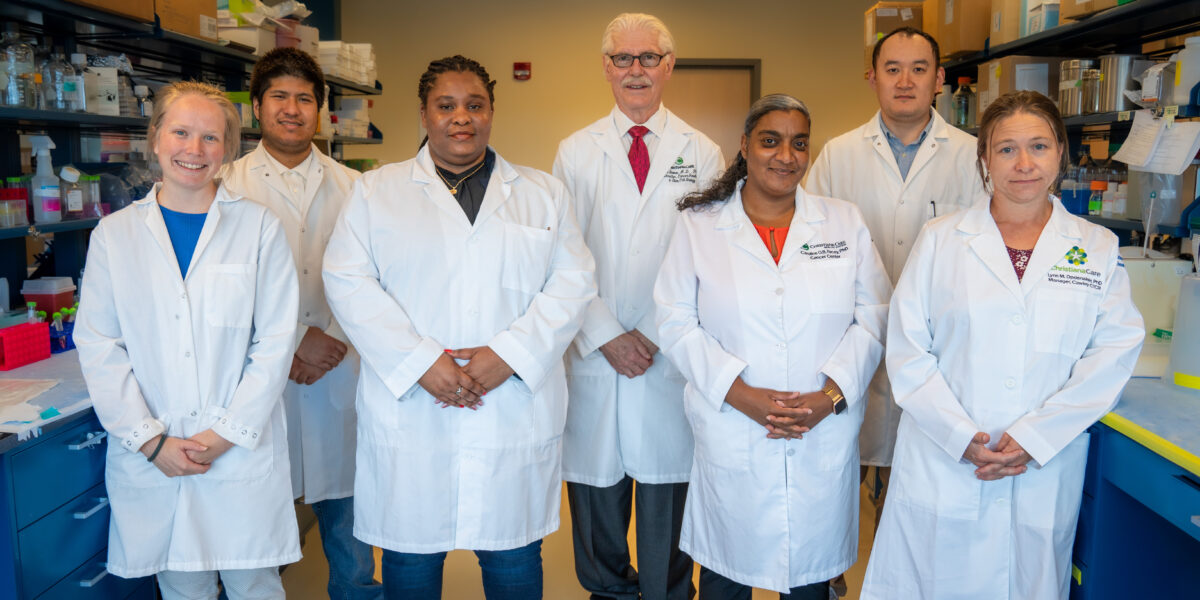In a major research discovery, scientists at ChristianaCare’s Helen F. Graham Cancer Center & Research Institute have uncovered a link between two main cellular pathways involved in the development of colorectal cancer. The link is an enzyme called CYP26A1 that is connected to retinoic acid (RA) and WNT (Wingless & Int-1) signaling, and its discovery opens the potential for a new treatment target for drug resistant colorectal cancers. Their report was published online Jan. 7 in the journal Cancers.

“Over the last few decades, our work has focused on how cancer stem cells play a role in the development and spread of colorectal cancer. Our goal is to find more effective therapeutic targets,” said Bruce Boman, M.D., Ph.D., MSPH, FACP, senior author and chief of the study’s research team at the Cawley Center for Translational Cancer Research at the Graham Cancer Center.
“With the identification of CYP26A1 as a link between WNT and RA signaling, we have, at last, a definitive approach to targeting the stem cell population that is driving tumor growth.”
Searching for a cure

Colorectal cancer is the second most deadly cancer worldwide, equally affecting both men and women. Conventional research over the last 50 years has been that cells undergo a series of genetic mutations that lead to the unchecked growth of tumors and their progression to metastatic cancer. Traditional therapies designed to kill the bulk of cancer tumor cells continue to fall short of a cure for advanced, drug-resistant colon cancers.
“Dr. Boman’s compendium of work leading to his most recent discovery brings us to the threshold of a novel targeted treatment for advanced colorectal cancer,” said Nicholas Petrelli, M.D., Bank of America endowed medical director of ChristianaCare’s Helen F. Graham Cancer Center & Research Institute.
“This research reflects the mission of the Cawley Center for Translational Cancer Research to hasten discoveries from bench to bedside and draws us even closer to a curative solution for this treatment resistant cancer.”
Previously, Boman and his research team described how colon cancer stem cells develop and flourish in the presence of a mutation in the APC (adenomatous polyposis coli) tumor suppressor gene. The researchers continued to uncover how these colon stem cells, identified as aldehyde dehydrogenase-positive (ALDH+) stem cells, progressively increase in number and fail to differentiate into mature neuroendocrine cells.
Colorectal cancer drivers resist treatment
Retinoid drugs, derived from vitamin A, have shown promise in treating a variety of cancers, particularly acute promyelocytic leukemia for which retinoid treatment regimens are curative. However, the overpopulating ALDH+ stem cells that drive colorectal cancer growth are a tougher breed that thus far have resisted conventional treatments including immunotherapy, chemotherapy or radiation.
“Our earlier work showed that RA signaling mainly occurs in ALDH+ stem cells and that the retinoic acid signaling pathway acts to induce differentiation and death of colon stem cells,” Boman said. “Consequently, when APC is mutant, the reduced or dysregulated RA signaling explains in part why these cancer stem cells remain immature and over-populate.”
The APC mutation present in about 85 percent of tumors is the most common genetic alteration associated with colorectal cancer. When APC is mutant, it activates WNT signaling which augments CYP26A1 expression that increases enzymatic degradation of retinoids and decreases RA signaling.
“Elevated CYP26A1 levels prevent differentiation of APC-mutated colorectal cancer stem cells by clearing out more retinoid acid, which reduces RA signaling,” said Boman.
The majority of colorectal cancer patient tumors the researchers examined expressed an increased level of CYP26A1 compared to normal colon tissue from the same patient. According to Boman, “Patients who did not carry the APC mutation expressed lower levels of CYP26A1 that leads to higher levels of RA in their tumor cells, which appears to afford these patients better survival.”
His findings support the existence of crosstalk between WNT and RA signaling that is governed by CYP26A1 expression and resultant RA levels as well as the APC genotype (normal or mutated) of the patients
New target: CYP26A1 enzyme
“To restore retinoid-induced differentiation and reduce stem cell numbers, CYP26A1 levels will need to be lowered by inhibiting WNT signaling so that cells can respond to retinoid drugs,” Boman said. “In other words, you have to repress CYP26A1 enzyme activity in order to get the full effect of the retinoids.”
With the understanding of how dysregulated CYP26A1 expression contributes to tumor growth, the researchers have begun drug testing in mice to target this mechanism with combinations of CYP26A1 and WNT signaling inhibitors along with cell differentiation-inducing agents such as all-trans retinoic acid. Boman believes these findings have strong potential for clinical application.
This study was supported in part by The Lisa Dean Moseley Foundation, The Cawley Center for Translational Cancer Research Fund, The Carpenter Foundation, University of Delaware Department of Biological Sciences, and National Institutes of Health.



